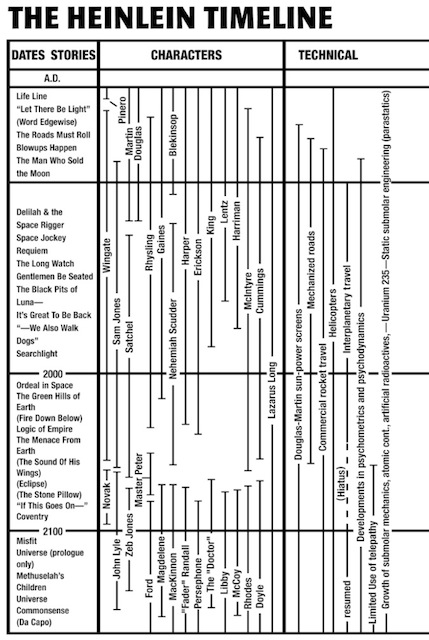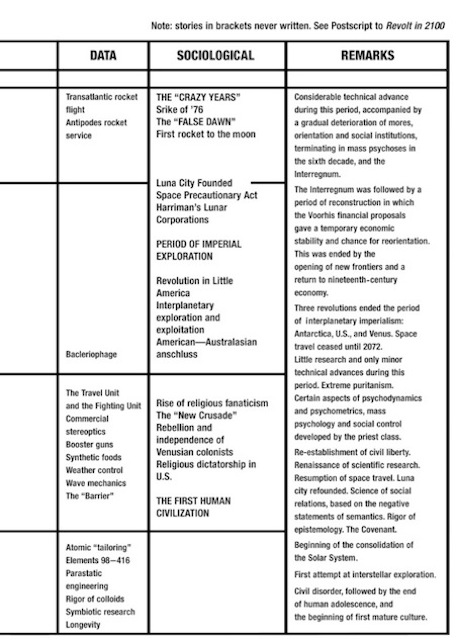Read Man Who Sold the Moon / Orphans of the Sky Online
Authors: Robert A Heinlein
Tags: #Fiction, #General, #Science Fiction, #Space Opera, #Action & Adventure
Man Who Sold the Moon / Orphans of the Sky





Two classic Robert A. Heinlein novels in one volume, with an all-new introduction by Mark L. Van Name, author of the Jon and Lobo military SF series.
The Man Who Sold the Moon
: D. D. Harriman is a billionaire with a dream: the dream of space for all mankind. The method?
Anything that works
. Maybe, in fact, Harriman goes too far. But he will give us the stars…
Orphans of the Sky
: Hugh had been taught that, according to the ancient sacred writings, the Ship was on a voyage to faraway Centaurus. But he also understood that this must be allegory for a voyage to spiritual perfection. After all, the real world was only metal corridors and nothing else, right? And then Hugh begins to suspect the truth. . .
Two all-time classics from seven-time Hugo winner and Dean of Science Fiction, Robert A. Heinlein.
THE MAN WHO SOLD THE MOON AND ORPHANS OF THE SKY
This is a work of fiction. All the characters and events portrayed in this book
are fictional, and any resemblance to real people or incidents is purely coincidental.
The Man Who Sold the Moon
© 1950, 1977 by Robert A. Heinlein, © 2003 by The Robert A. and Virginia Heinlein Prize Trust
Orphans of the Sky
copyright © 1963 by Robert A. Heinlein, © 1988 by The Robert A. and Virginia Heinlein Library Foundation
Introduction copyright © 2013 by William A. Patterson.
Afterword copyright © 2013 by Mark L. Van Name.
All rights reserved, including the right to reproduce this book or portions thereof in any form.
A Baen Book
Baen Publishing Enterprises
P.O. Box 1403
Riverdale, NY 10471
www.baen.com
ISBN: 978-1-4516-3922-3
Cover art by Bob Eggleton
First Baen printing, September 2013
Distributed by Simon & Schuster
1230 Avenue of the Americas
New York, NY 10020
Library of Congress Cataloging-in-Publication Data
Heinlein, Robert A. (Robert Anson), 1907-1988.
[Novels. Selections.]
Man who sold the moon and Orphans of the sky / Robert A. Heinlein.
pages cm.
Includes bibliographical references and index.
ISBN 978-1-4516-3922-3 (pbk.)
1. Science fiction, American. I. Heinlein, Robert A. (Robert Anson), 1907-1988. Man Who Sold the Moon. II. Title.
PS3515.E288M37 2013
813'.54--dc23
2013025463
Printed in the United States of America
10 9 8 7 6 5 4 3 2 1
Baen Books by
Robert A. Heinlein
Assignment in Eternity
Beyond This Horizon
Between Planets
Farmer in the Sky
Farnham’s Freehold
The Green Hills of Earth
The Green Hills of Earth & The Menace from Earth (omnibus)
The Man Who Sold the Moon
The Man Who Sold the Moon & Orphans of the Sky (omnibus)
The Menace from Earth
Orphans of the Sky
Revolt in 2100 & Methuselah’s Children
Expanded Universe
The Rolling Stones
The Puppet Masters
Sixth Column
Starman Jones
The Star Beast


Introduction
William H. Patterson, Jr.
The stories that make up
The Man Who Sold the Moon
were among the first Heinlein wrote. Both “Life-Line” (his Opus 2) and “‘Let There Be Light’” (Opus 4) nominally took place when they were written, in April and May of 1939. It was not at first obvious to others that they belonged to a “history of the future,” but they were all—plus many more—on a handwritten wall chart Heinlein kept by his writing desk and typewriter, scribbling ideas on the chart in pencil as they came to him. Some of the stories simply gave a view of the future-historical timeline as it developed; others showed “inflexion points,” where a new invention or social force changed the direction of the development. The Martin-Douglas Sun-Power screens of “‘Let There Be Light,’” for example, enabled all the other technological innovations that were to come.
Heinlein had mined the idea of an extended development from the backstory of his unsold Opus 1 utopian novel,
For Us, the Living.
He planned out an extended story arc of how we could get from the misery of the Great Depression to a great human civilization spreading through space and meeting man’s future head on.
We might never have known about this Future History except for an ordinary kink in the career path of a professional writer: in the spring of 1939 Heinlein was writing all sorts of short (and not so short) fiction. All of them went first to John W. Campbell, Jr., for
Astounding
or for its sister magazine,
Unknown
—but the only stories that piqued Campbell’s interest were the stories coming out of the utopian backstory. He passed up half a dozen of the others but purchased “Life-Line,” then “Misfit” after a few revisions; “‘If this Goes On—’” and “Requiem” and “Coventry” he purchased on sight. And
then
“Magic, Inc.” broke the string of non-Future-History rejections—followed by still more of the chart stories.
Heinlein visited Campbell in New York in June 1940 and told Campbell about his wall chart and his master plan for a history of the future. Campbell was wild to publish the chart, and it appeared in the May 1941 issue of
Astounding
, along with “Solution Unsatisfactory” (Opus 21) and the new Future History story, “Universe” (Opus 22)—the first half of
Orphans of the Sky
.
Heinlein’s first plan for the Future History—the one he typed up for John Campbell to publish in the May 1941
Astounding
—went from “Life-Line” and “‘Let There Be Light,’” both of which nominally took place in 1939, the year they were written, to the prolog to “Universe,” not quite two hundred years later.
The two stories of “Universe” and “Common Sense” take place quite some time after the prolog, so they were in the most literal sense “off the chart.” They had been conceived together as a single long story, of about 50,000 words (a proper size for a pulp serial) but Campbell had a backlog of long fiction, so Heinlein and wrote the shorter half, “Universe,” as a 17,000 word novelette in May of 1941
Astounding
, but did not write the longer end half as a novella for seven months, when Campbell had a 23,000 word hole in his publishing schedule. “Common Sense” was published in October 1941, and the Future History was more or less complete.
In 1948 Heinlein received a proposal for a book series that would contain the whole of the Future History and for which he would be able to finish the stories on his chart that he had not found opportunity to write, and the Future History series was launched again in 1950. But the publisher’s business methods ran the company into the ground a few years later and only three of the collections were issued—
The Man Who Sold the Moon
,
The Green Hills of Earth and Other Stories
(1951), and
Revolt in 2100
(1953). Heinlein included in that last collection an apologia “Concerning Stories Not Written,” about the novellas he did not write. He gave several reasons for the gaps he left in the Future History, all of them probably true—certainly Nehemiah Scudder was an unlikeable character—but leaving out what was almost certainly the main reason he did not write those long stories after the first one: “The Man Who Sold the Moon” (which was awarded a Retro-Hugo in 2001) was in great demand for reprints, but the contract restricted it to the publisher’s use for years. Heinlein lost thousands of 1950’s dollars in secondary sales and concluded that writing for this publisher was not worth the trouble.
Another publisher brought out
Methuselah’s Children
in 1958. The fifth book never came about—but in 1963 the British publisher Gollancz put “Universe” and “Common Sense” together as
Orphans of the Sky
. “Universe” and “Common Sense” together explore some themes that seem a little disconnected from the mainstream of the Future History—but, then again, the Future History itself was reshaped by the series of “Luna City” stories Heinlein wrote for the
Saturday Evening Post
(and other “slicks”) six years later, after World War II.
In “Universe,” the voyagers of a generation starship, hundreds of years after a shipboard revolt, have fallen into a dark age and have even forgotten that they are on board a ship at all. Their intellectual universe is bounded by the steel of the ship, and into this dark age comes the first gleam of a universe beyond.
“Universe” challenges our acceptance of the circumstances we encounter as “normal” and might also be read as an extended gloss on one of Heinlein’s favorite quotations, from George Bernard Shaw’s
Caesar and Cleopatra
: “Pardon him, Theodotus: he is a barbarian, and thinks that the customs of his tribe and island are the laws of nature.”
“Common Sense” makes a specifically political conflict out of this material and poses the conflict of truth against the orthodoxy of social opinion—the “common sense” that is insane (surely a notion that has exceptional currency in the early years of the 21st Century!). Until
Time Enough for Love
, written in 1972, this was Heinlein’s last word on the Future History.
The book you have in your hands, therefore, is Robert Heinlein’s original conception of the beginning and the end of the Future History—more or less: the earliest stories in
The Man Who Sold the Moon
took place in Heinlein’s here-and-now of 1939; but the events of “Universe” and “Common Sense” took place in the undiscovered country of the far future—thematically as well as chronologically “off the chart.”
